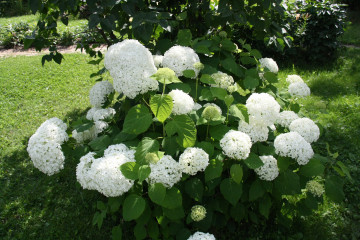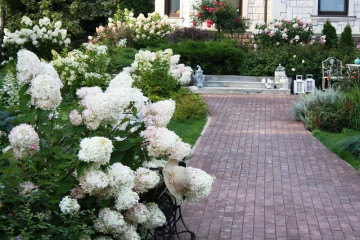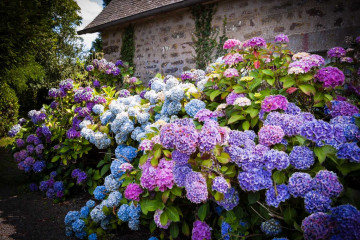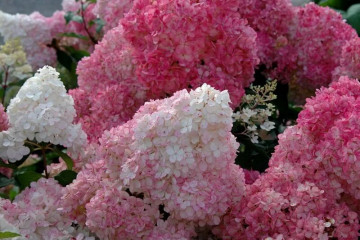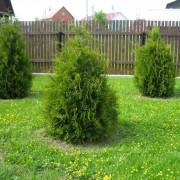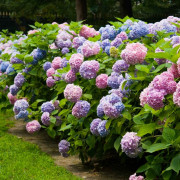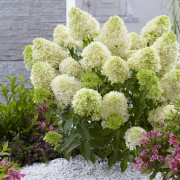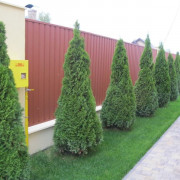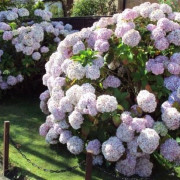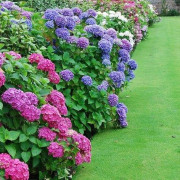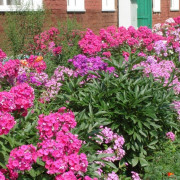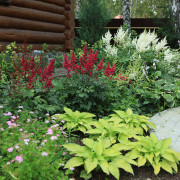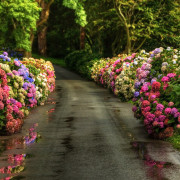Hydrangea Vanilla Fraz - planting and care in the open field
Content:
Hydrangea is widespread in the garden plots of Central Russia due to its moderate frost resistance and attractive appearance. The first plant species were white and brown. Later, varieties of other shades were bred, capable of changing color due to a change in external conditions. Variety Vanilla Fraze is successfully grown not only in the south of the country and in the Central zone, but also in Siberia.
Origin and appearance
Work on the creation of a paniculate garden culture capable of changing color has been carried out since the end of the 19th century. in France. Hydrangea Vinyl frieze is the result of selective breeding, which is why it was able to give a number of characteristics.
The stems of the plant are burgundy in color. Shoots are straight and tough, under the weight of the vegetative part, the bush takes on a spherical shape. Leaves are oval, oblong. Inflorescences are cone-shaped, oblong, consisting of large flowers of a rich pink hue at the base, passing to vanilla at the top.
Flowering description
The plant is characterized by flowering in several stages. It starts in mid-June and lasts until October. By summer, buds appear, blooming like white flowers. Then they gradually turn to pink. In the fall, you can observe that the inflorescences become burgundy-red.
Hydrangea Vanilla Fraze on the trunk
Some horticultural crops are grown by giving them the shape of a tree for decorative purposes. The part of the trunk up to the first lower tier of the stem is called the stem. Planting and caring for a tree trunk takes patience and time. It will take at least three years to get a standard culture.
The idea of forming a tree from hydrangea is based on the fact that young shoots acquire a rough bark and cannot start young shoots. Further development continues only the top of the plant.
Hydrangea Vanilla Fraze: planting and care in the open field
Hydrangea Vanilla Frazi, planting and caring for which in the open field includes several stages, will eventually bloom all summer. First you need to choose a suitable place for planting, then provide food for the bush, care.
What is needed for landing
The plant is demanding on the quality of the soil and the level of moisture. Therefore, the pit where the shoot will be planted must be filled with nutritious soil. It should consist of a mixture of peat, humus and sand in a ratio of 2: 2: 1.
Choosing the best place
It depends on the region where the landing takes place. In the northern part of the country, you need to choose a southern location not in the sun. On the territory of the central part, you can plant a shrub in partial shade.
Step-by-step planting process
The shoot must be replanted in the spring, it is allowed in the fall before frost. In the nursery, they take young shoots without signs of disease, about 30 cm high.Planting hydrangea Vanilla Fraze in the spring includes a sequence of actions:
- At a distance of 1-2 m, holes of 50 cm² are dug.
- After preparing the nutrient soil, add superphosphate and potassium fertilizer.
- 2 weeks before disembarkation, fill each pit halfway with the mixture.
- After the soil subsides, a seedling is placed in it, soaked for 2 hours in a growth stimulator.
- Sprinkle with warm soft water.
While the bush takes root, you need to water it often.
Propagation of hydrangea Vanilla Freise
There are several ways to propagate a plant. The most common option is cuttings, although seedlings can also be grown at home. Another way is to divide the bush, when in the spring several shoots with a root system are separated from an adult hydrangea.
Propagation by cuttings
This breeding method is used in the summer. To get a cutting, you need to cut off a part of a young shoot with 3-4 buds. It is first lowered into a container with a growth stimulant. Then they are planted in nutrient soil by 2-2.5 cm. A mixture of peat and sand in equal proportions is suitable.
Cover the planting area with a jar or plastic bottle until the first leaves appear. After the plant has overwintered in a small container, the sprouts must be planted in open ground.
Growing from seeds
This is a more rare and time consuming process. The seeds are soaked in a solution of potassium permanganate, then dried.
Drainage from small stones or expanded clay is placed at the bottom of the pot. The container is filled with soil for flower crops. The material is spread on the surface of the soil, moistened, slightly sunk into the depths.
When 2-3 leaves appear on the surface, the seedlings are dived, that is, they are seated in different containers.
Grooming and pruning
After planting and rooting the shoot, you need to provide proper care for it. You need to know what growth conditions are most optimal for flowering.
Watering mode
The first point, how to care for the sprout, is compliance with the watering regime. Hydrangea belongs to moisture-loving plants. If it is located on the south side and the sun is shining on it, then the frequency of watering is at least 2 times a week, 30-50 liters for each bush.
So that in summer the moisture does not evaporate prematurely, sawdust or rotten foliage is poured around the shoots. To determine that it is time to water the plant again, you can use the dried soil around the bush.
Top dressing
The first year, feeding is not needed, since the shoot is planted in a nutrient medium. Next, you need mineral fertilizers (saltpeter, phosphates).
Top dressing consists of several stages. The first is shortly after awakening, the second is before flowering. This is necessary to activate the budding process. After flowering, the bush is fertilized using special products for azaleas or hydrangeas. The last stage is before wintering.
Features of care during the flowering period
During the active period, all the hydrangea needs is to water often and not to feed. If the place is chosen correctly, then the plant can bloom all summer until the first frost, adding 50 cm in growth every year.
Features of care during the rest period
With the arrival of autumn, at the end of flowering, watering is reduced, feeding is stopped. The plant does not require active action, in addition to preparing for winter. During this time, the scions can be dug up and placed in home storage. The pots are kept in a dark place until spring, until it is time to plant them outside.
Bush formation and pruning
In the spring, even before the beginning of the vetegative period, you need to prune the bush. Dried flowers are removed, as well as frozen shoots.In order for the bush to acquire the desired shape, you also need to cut the stems that are too long.
Preparing for winter
The plant is frost-resistant, so it can comfortably tolerate temperatures down to -35 ° C. Shoots of the first year of life need insulation. The bushes are sprinkled with sawdust, foliage. Small ones are covered with boxes or covered, tied with twine. It is necessary to open the bush after the snow melts and the warm weather settles.
Thus, hydrangea Vanilla Fraze is loved by many for its unusual type of inflorescence: first, the flower cone is white, then it turns pink. On the bush, there are specimens with varying degrees of staining of the buds. This hydrangea variety is one of the most frost-resistant, but young plants need shelter for the winter.




